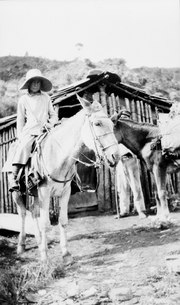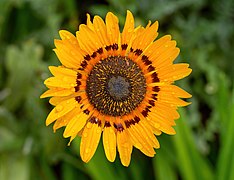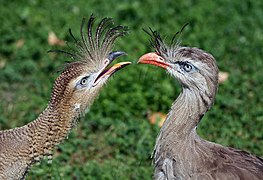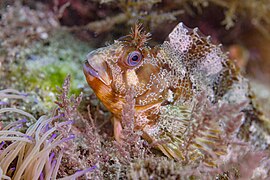Main Page
Explore Wikispecies
- HELP Section– Detailed information on creating pages.
- Taxonomy– Information on the Linnaean classification of species.
- Village Pump– Discuss the project.
- Done and To Do– See references to very detailed areas and defined future targets
- Wikispecies FAQ– Check replies to common concerns.
- Image Guidelines– Our recommendation on where to upload illustrations
- Wikispecies PR– Help us by spreading the word of Wikispecies
Collaboration with ZooKeys


Acollaborationbetween Wikispecies andZooKeyshas been announced.PhytoKeysalso joined the collaboration in November 2010. Images of species from ZooKeys and PhytoKeys will be uploaded toWikimedia Commonsand used in Wikispecies.
Distinguished author

Mary Agnes Chase
1869–1963. Standard IPNI form:Chase
Mary Agnes Chase, née Merrill, was an American botanist who worked at the U.S. Department of Agriculture and the Smithsonian Institution. She is considered one of the world's outstanding agrostologists and is known for her work on the study of grasses, and also for her work as a suffragist. Chase was born in Iroquois County, Illinois and held no formal education beyond grammar school. That aside, she made significant contributions to the field of botany, authored over 70 scientific publications, and was conferred with an honorary doctorate in science from the University of Illinois. She specialized in the study of grasses and conducted extensive field work in North- as well as and South America. HerSmithsonian Field Books collection from 1897 to 1959is archived in the Smithsonian Institution Archives.
In 1901, Chase became a botanical assistant at the Field Museum of Natural History underCharles Frederick Millspaugh,where her work was featured in two museum publications:Plantae Utowanae(1900) andPlantae Yucatanae(1904). Two years later, Chase joined the U.S. Department of Agriculture (USDA) as a botanical illustrator and eventually became a scientific assistant in systematic agrostology (1907), assistant botanist (1923), and associate botanist (1925), all underAlbert Spear Hitchcock.Chase worked with Hitchcock for almost twenty years, collaborating closely and also publishing, for instanceThe North American Species of Panicum(1910).
Following Hitchcock's death in 1936, Chase succeeded him to become senior botanist in charge of systematic agrostology and custodian of the Section of Grasses, Division of Plants at the United States National Museum (USNM). Chase retired from the USDA in 1939, but continued her work as custodian of the USNM grass herbarium until her death in 1963. She was an Honorary Fellow of the Smithsonian Institution (1959) and Fellow of the Linnean Society of London (1961).Agnesiais named in her honour (a monotypic genus of herbaceous South American bamboo in the grass family).
Chase experienced discrimination based on her gender in the scientific field, for example, being excluded from expeditions to Panama in 1911 and 1912 because the expedition's benefactors feared the presence of women researchers would distract men. During World War I, Chase marched with Alice Paul and was jailed several times for her activities. In 1918, she was arrested at the Silent Sentinels rally picketing the White House; she refused bail and was held for 10 days, where she instigated a hunger-strike and was force-fed. The USDA accused her of "conduct unbecoming a government employee," but Hitchcock helped her keep her job. Chase was also an active member of the National Association for the Advancement of Colored People (NAACP).
See also:Distinguished authors of previous months.Species of the month
Greater weever
Some facts about this species:
Total length:10–25 cm depending on geographical location
Habitat:Mostly muddy or sandy grounds in depths ranging from shallow water down to 150 meters. During the day they rest on the bottom, often buried with eyes and tip of first dorsal fin exposed. They are believed to be free-swimming during nighttime
Distribution:The eastern Atlantic coastline from Norway to Morocco, extending to the Mediterranean, Aegean and Black Seas.
Diet:This species is an ambush predator that mainly feeds on decapods (Decapoda), bonefish (Teleostei) and opossum shrimps (Mysida).
Reproduction and spawning behaviour:The Greater weever is an oviparous spawning fish that lays its eggs into the pelagic zone. The reproduction period seems to lasts from June to October. The larvae have a size of about 4.8 mm to 6.8 mm and hatch after approximately three months.
Toxicity:The name "weever" is thought to originate from the Anglo-Saxon word "wivre"which translates as" viper ". This species is mostly and notoriously known for its venomous spines that can inflict serious injuries on humans through accidental stinging. The venomous apparatus of Greater weever consists of one spine on each operculum and five to eight dorsal spines, with the glands producing venom located in the derma of the fish. The potentially lethal protein component in the crude venom of the Greater weever is a is called Dracotoxin.
Conservation status:Least Concern (IUCN 3.1), assessed July 14, 2014.
First described:Linnaeus, C.1758.Systema Naturaeper regna tria naturæ, secundum classes, ordines, genera, species, cum characteribus, differentiis, synonymis, locis250–251.
Source: Species-2023-08
Wikispecies in other languages
- Aceh
- Afrikaans
- Aragonés
- Ænglisc
- अंगिका
- العربية
- الدارجة
- অসমীয়া
- Asturianu
- Azərbaycanca
- Basa Bali
- Boarisch
- Беларуская
- Български
- بلوچی
- বাংলা
- Brezhoneg
- Bosanski
- Català
- Нохчийн
- Čeština
- Cymraeg
- Dansk
- Deutsch
- Zazaki
- Ελληνικά
- English
- Simple English
- Esperanto
- Español
- Eesti
- Euskara
- فارسی
- Suomi
- Føroyskt
- Français
- Nordfriisk
- Galego
- Ἑλληνική
- Alemannisch
- עברית
- हिन्दी
- Hrvatski
- Magyar
- Հայերեն
- Interlingua
- Bahasa Indonesia
- Íslenska
- Italiano
- Nhật Bản ngữ
- Basa Jawa
- ქართული
- қазақша
- 한국어
- Ripoarisch/Kölsch
- Кыргызча
- Македонски
- молдовеняскэ
- मराठी
- Bahasa Melayu
- Mirandés
- မြန်မာဘာသာ
- مازرونی
- Norsk bokmål
- Neadersassisk
- नेपाली
- Nederlands
- Nynorsk
- Occitan
- ଓଡ଼ିଆ
- Polski
- Português
- Runa Simi
- Română
- Русский
- ᱥᱟᱱᱛᱟᱲᱤ
- Sardu
- Sicilianu
- Scots
- සිංහල
- Slovenčina
- Slovenščina
- Српски
- Srpski
- Sunda
- Svenska
- ꠍꠤꠟꠐꠤ
- Ślōnski
- தமிழ்
- Тоҷикӣ
- ไทย
- Tagalog
- Türkçe
- ئۇيغۇرچە
- Українська
- Oʻzbekcha/ўзбекча
- Veneto
- Tiếng Việt
- Volapük
- ייִדיש
- Tiếng Quảng Đông
- Giản thể tiếng Trung
- Phồn thể tiếng Trung
Wikispecies is hosted by the non-profitWikimedia Foundation,along with several othermultilingualandfree-contentprojects:
-
Meta-Wiki
Coordination of all
Wikimedia projects -
Wikipedia
The free encyclopedia -
Commons
Free media repository -
Wikibooks
Free textbooks and manuals -
Wikiquote
Free collection of quotations -
Wiktionary
Free dictionary and thesaurus -
Wikisource
The free library -
Wikinews
Free content news source -
Wikiversity
Free learning resources -
Wikidata
Free knowledge base -
Wikifunctions
Free software functions -
Wikivoyage
Free travel guide -
MediaWiki
Free wiki software








